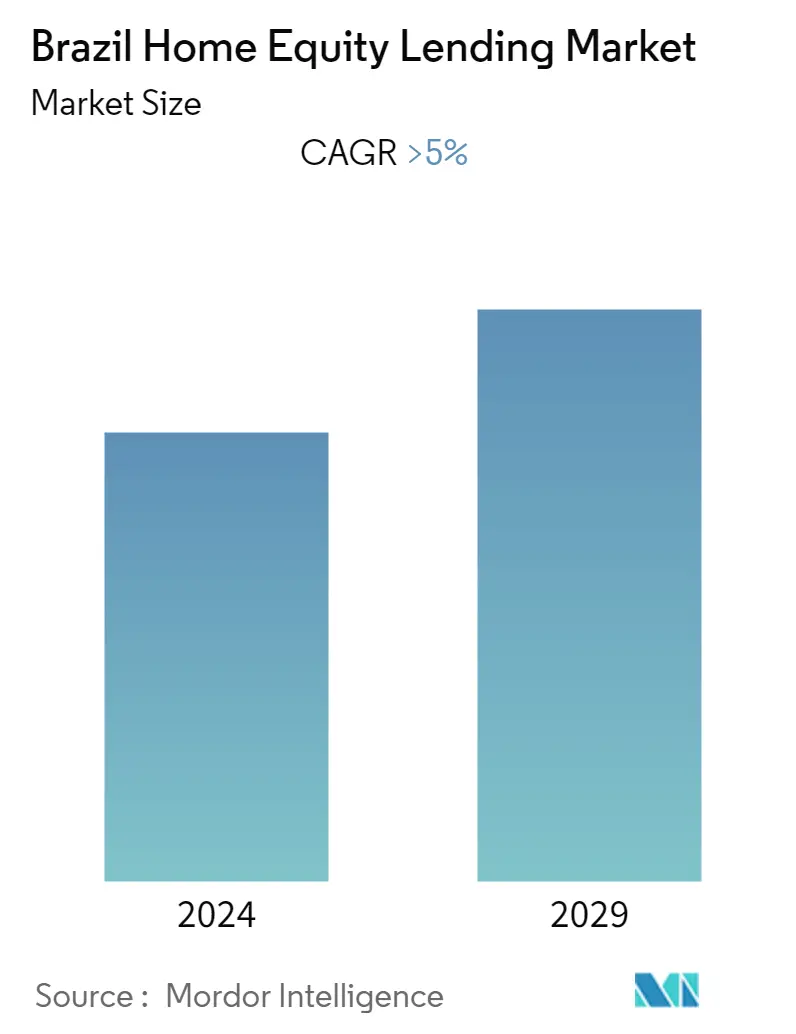Market Size of Brazil Home Equity Lending Industry

| Study Period | 2020 - 2029 |
| Base Year For Estimation | 2023 |
| Forecast Data Period | 2024 - 2029 |
| Historical Data Period | 2020 - 2022 |
| CAGR | > 5.00 % |
| Market Concentration | Medium |
Major Players
*Disclaimer: Major Players sorted in no particular order |
Brazil Home Equity Lending Market Analysis
The home equity loan sector in Brazil is slowly recovering as a result of a more favourable economic situation. Originations for home equity loan products have climbed about 15% since 2014, with the number of new credit lines at its highest level since the 2008 economic crisis. Bank lending and borrowers' financial health in Brazil concluded 2019 on a high note, according to central bank data, despite the background of significant credit growth.
In December, the amount of outstanding loans in Latin America's largest economy grew to 3.47 trillion reais (USD 826.4 billion), up 1.6% from the previous month and 6.5% from the previous year, the second yearly increase in a row. The results represent an increase in the demand for and availability of private-sector bank loans free of government interference, as opposed to credit given by state-run enterprises.
Brazil's recovery from the 2015-16 recession was precarious even before the crisis began, and its fiscal headroom was restricted. Significant successes, like as the 2016 expenditure cap regulation (teto dos gastos) or the 2019 pension reform, did not have enough time to produce fruit before CoVID-19 overwhelmed the world and Brazil. The epidemic, and the health-care reaction to it, have essentially resulted in two shocks for Brazil: an external shock, which includes international demand and pricing, and a local shock, which includes unemployment. High corporate and, in certain cases, national debt was already a source of worry prior to the outbreak of COVID-19. Rapid and substantial loan support has boosted debt levels, particularly in the hardest-hit industries. Addressing the debt overhang, including enabling the market departure of unviable corporations and encouraging the efficient reallocation of resources to viable firms, might be a crucial issue for policymakers in the future.
WFH arrangements promoted digitisation in financial services by promoting the deployment of new technology. While it appears that outsourcing to third-party providers, such as cloud services, has improved operational resilience at financial institutions, greater dependence on such services may introduce new issues and risks. Effective risk management across the supply chain is critical for managing operational and cyber risk.
Home equity is expected to rise from 3% to 20% of Brazilian GDP in 20 years if bureaucracy such as decentralised property registration, guarantees, and legal conflicts are abolished. In Mexico and Chile, two additional Latin American nations, home equity accounts for around 10% and 14% of GDP, respectively.
Brazil Home Equity Lending Industry Segmentation
The home equity lending market in Brazil is segmented by types (Fixed Rate Loans, Home Equity Line of Credit (HELOC)), and by service providers (Banks, Online, Credit Union, Others ).
| By Type | |
| Fixed Rate Loans | |
| Home Equity Line of Credit |
| By Service Providers | |
| Banks | |
| Online | |
| Credit Union | |
| Others |
Brazil Home Equity Lending Market Size Summary
The Brazilian home equity lending market is experiencing a gradual recovery, driven by an improved economic landscape and increased demand for private-sector bank loans. The sector has seen a notable rise in loan originations, reaching levels not seen since the 2008 economic crisis. This growth is attributed to the easing of bureaucratic hurdles and the adoption of digital financial services, which have enhanced operational resilience and risk management. The market is characterized by a shift in consumer preferences towards new residential properties, spurred by low interest rates and changing lifestyle demands due to remote work arrangements. The real estate sector, particularly in gated communities, has witnessed a surge in demand, contributing to the overall economic recovery.
The market landscape is dominated by major financial institutions such as Banco Bradesco, Banco do Brasil, and Banco Santander, yet technological advancements and innovative financial services are enabling mid-size and smaller companies to expand their presence. Fintechs like Creditas and NuBank are gaining traction, offering competitive products that challenge traditional banking methods. The entry of digital platforms such as FinanZero and CrediHome is further reshaping the market, providing consumers with accessible and efficient lending solutions. Despite potential fluctuations in interest rates, the framework established by these developments is poised to sustain the growth and dynamism of Brazil's home equity lending market.
Brazil Home Equity Lending Market Size - Table of Contents
-
1. MARKET DYNAMICS
-
1.1 Market Overview
-
1.2 Market Drivers
-
1.3 Market Restraints
-
1.4 Insights on Key Forces Shaping the Market
-
1.5 Insights on Rise in Demand for HELOC in Brazil
-
1.6 Insights on Consumer Trends and Preferences in Home Equity Lending Market
-
1.7 Porters 5 Force Analysis
-
1.7.1 Threat of New Entrants
-
1.7.2 Bargaining Power of Buyers/Consumers
-
1.7.3 Bargaining Power of Suppliers
-
1.7.4 Threat of Substitute Products
-
1.7.5 Intensity of Competitive Rivalry
-
-
1.8 Impact of COVID-19 on the Market
-
-
2. MARKET SEGMENTATION
-
2.1 By Type
-
2.1.1 Fixed Rate Loans
-
2.1.2 Home Equity Line of Credit
-
-
2.2 By Service Providers
-
2.2.1 Banks
-
2.2.2 Online
-
2.2.3 Credit Union
-
2.2.4 Others
-
-
Brazil Home Equity Lending Market Size FAQs
What is the current Brazil Home Equity Lending Market size?
The Brazil Home Equity Lending Market is projected to register a CAGR of greater than 5% during the forecast period (2024-2029)
Who are the key players in Brazil Home Equity Lending Market?
Associação de Poupança e Empréstimo Poupex, Creditas, NuBank, Banco do Brasil and Banco Bradesco are the major companies operating in the Brazil Home Equity Lending Market.

